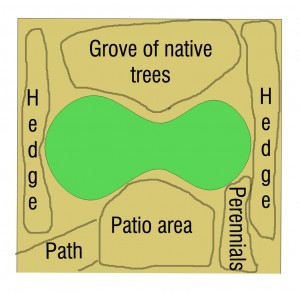I’ve written about eliminating the lawn before (Tyranny of the turf), but maybe you just want to make it a little less of a burden. We can do this by altering it’s shape and size. To do this, let’s consider the use of positive and negative space in garden.
How does the typical garden layout start?
Most yards usually start with a default material of grass. From this we usually subtract out of that a walk from the driveway to the front door and rectangular patio off the back door.
We are in essence cutting out of our grass, different spaces in different shapes. They may be square, circles or rectangles.
We may have noticed most garden beds are shaped from curved lines. So we add beds of curving shapes in which we place shrubs to block the view of a neighbor or help to define our property lines.


Then we start adding more beds to create more privacy and perhaps grow some of our favorite plants and flowers. We make these beds out of different shapes. The flower beds might be curvy while a vegetable garden may be a rectangle.

What are we left with?
While the beds we are making are made of shapes. One thing that is not usually considered is what is the shape of the turf that is left behind?
This left behind shape is considered the negative space. No not negative like Winnie the Pooh’s less then enthusiastic friend Eeyore, but instead what is left behind when the positive shapes are removed.

Think of a rolled-out sheet of cookie dough. The cookies that are cut out from the dough is the positive space. The left over scraps of dough is the negative space.


How to avoid a lot of wasted “dough”
This odd shaped grass is not the most aesthetically pleasing shape. It also demands being mowed and trimmed. Both of which become more work when planting beds and patios are cut out of it.


One big cookie
How about we flip the process around and make one big cookie out of our pile of dough?
By that I mean pick a positive shape for our lawn area and leave what is left (the negative space) as planting areas.
You might object, then our planting area will be an odd shaped negative space! That’s OK as
Positive spaces are almost always preferred by people for lingering…” –101 Things I Learned in Architecture School
by Matthew Frederick
Not only do we prefer to be in positive shaped spaces, we can also make negative spaces a lot more interesting by adding vertical interest to your planting beds that you can’t add to your lawn area.
Parts of your planting area can be a grove of trees, a mixed shrub planting, a sea of ground covers, a meadow, a vegetable garden, a pond even. All much different and potentially more interesting then our monoculture of grass.
Not only that but lawn maintenance can be reduced by designing the lawn areas to be one continuous, easy-to-mow area.

If we pick a good shape, we can eliminate corners. This makes mowing easier and quicker because you don’t have to stop, back-up and forward over and over again.
If thoughtfully planned, this non-lawn areas can also bring wildlife, such as birds and butterflies into your yard. They can be a grove of trees, a meadow of wildflowers, a planting of ornamental grasses. They could be a simple ground cover, bark mulch, or a low-maintenance, drought-tolerant xeriscape. It could be combination of those.

Remember any “islands” in the grass, such as trees or flower beds will slow down your mowing. By thinking about the positive and negative space in the garden, planing your garden becomes easier.
If you limit your turf to a simple, easy to care, positive shaped space you will thank yourself after every mow as well as have a space you can enjoy lingering in.
Leave a Reply